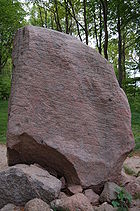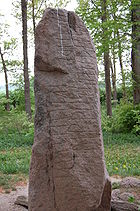
Glavendrup stone
Encyclopedia



Rundata
The Scandinavian Runic-text Data Base is a project involving the creation and maintenance of a database of runic inscriptions. The project's goal is to comprehensively catalog runestones in a machine-readable way for future research...
, is a runestone on the island of Funen
Funen
Funen , with a size of 2,984 km² , is the third-largest island of Denmark following Zealand and Vendsyssel-Thy, and the 163rd largest island of the world. Funen is located in the central part of the country and has a population of 454,358 inhabitants . The main city is Odense, connected to the...
in Denmark
Denmark
Denmark is a Scandinavian country in Northern Europe. The countries of Denmark and Greenland, as well as the Faroe Islands, constitute the Kingdom of Denmark . It is the southernmost of the Nordic countries, southwest of Sweden and south of Norway, and bordered to the south by Germany. Denmark...
and dates from the early 10th century. It contains Denmark's longest runic inscription and ends in a curse
Curse
A curse is any expressed wish that some form of adversity or misfortune will befall or attach to some other entity—one or more persons, a place, or an object...
.
Description
The runestone forms the end of a stone shipStone ship
The Stone ship or ship setting was an early Germanic burial custom, characteristically Scandinavian but also found in Germany and the Baltic states. The grave or cremation burial is surrounded by tightly or loosely fit slabs or stones in the outline of a ship...
. There are other megalith
Megalith
A megalith is a large stone that has been used to construct a structure or monument, either alone or together with other stones. Megalithic describes structures made of such large stones, utilizing an interlocking system without the use of mortar or cement.The word 'megalith' comes from the Ancient...
s in the vicinity, including memorial stones with Latin characters from the early 20th century. In the stone ship, nine graves have been found, but they were all empty.
The runestone was discovered when sand was quarried in the area in 1794, and it was saved in 1808 by the archaeologist Vedel Simonssen when stonemasons wanted to buy it. The last restoration was made in 1958, and the mound it is standing on is modern.
Ragnhild who ordered the stone also ordered the Tryggevælde Runestone
Tryggevælde Runestone
Tryggevælde Runestone, designated as DR 230 under Rundata, is a runestone housed in the National Museum of Denmark, in Copenhagen. It is classified as being carved in runestone style RAK, and is dated to about 900 CE.-Description:...
(DR 230) from the runemaster
Runemaster
A runemaster or runecarver is a specialist in making runestones.Most early medieval Scandinavians were probably literate in runes, and most people probably carved messages on pieces of bone and wood. However, it was difficult to make runestones, and in order to master it one also needed to be a...
Soti. The runic inscription is classified as being in runestone style
Runestone styles
The runestone styles varied during the Viking Age. The early runestones were simple in design, but towards the end of the runestone era they became increasingly complex and made by travelling runemasters such as Öpir and Visäte....
RAK. This is the classification for inscriptions with text bands with straight ends that do not have attached serpent or beast heads. It refers to a gothi
Gothi
A goði or gothi is the Old Norse term for a priest and chieftain. Gyðja signifies a priestess.The name appears in Wulfila's Gothic language translation of the bible as gudja for "priest", but in Old Norse it is only the feminine form gyðja that perfectly corresponds to the Gothic form...
, who was a pagan priest of a vé
Vé (shrine)
In Germanic paganism, a vé or wēoh is a type of shrine or sacred enclosure. The term appears in skaldic poetry and in place names in Scandinavia , often in connection with a Norse deity or a geographic feature. The name of the Norse god Vé, refers to the practice...
, a holy sanctuary, and a thegn
Thegn
The term thegn , from OE þegn, ðegn "servant, attendant, retainer", is commonly used to describe either an aristocratic retainer of a king or nobleman in Anglo-Saxon England, or as a class term, the majority of the aristocracy below the ranks of ealdormen and high-reeves...
, who was the head of the Norse clan
Norse clans
The Scandinavian clan or ætt was a social group based on common descent or on the formal acceptance into the group at a þing.-History:...
and a warchief. The rune carver appeals to the Norse god Thor
Thor
In Norse mythology, Thor is a hammer-wielding god associated with thunder, lightning, storms, oak trees, strength, the protection of mankind, and also hallowing, healing, and fertility...
to hallow
Hallow
To hallow is "to make holy or sacred, to sanctify or consecrate, to venerate". The adjective form hallowed, as used in The Lord's Prayer, means holy, consecrated, sacred, or revered.-Etymology:...
the inscription. There are two other runestones that have similar invocation
Invocation
An invocation may take the form of:*Supplication or prayer.*A form of possession.*Command or conjuration.*Self-identification with certain spirits....
s to Thor located in Denmark, DR 110 from Virring and DR 220
Sønder Kirkeby Runestone
The Sønder Kirkeby Runestone, listed as runic inscription DR 220 in the Rundata catalog, is a Viking Age memorial runestone that was discovered in Sønder Kirkeby, which is located about 5 kilometers east of Nykøbing Falster, Denmark.-Description:...
from Sønder Kirkeby, and three other stones in Sweden, Ög 136
Rök Runestone
The Rök Runestone is one of the most famous runestones, featuring the longest known runic inscription in stone. It can now be seen by the church in Rök , Östergötland, Sweden...
in Rök, Sö 140 in Korpbron, and Vg 150
Velanda Runestone
The Velanda Runestone, designated as Vg 150 in the Rundata catalog, is a runestone that is dated from the late tenth century or the early eleventh century and which is located in the village of Velanda, which is about 8 kilometers southeast of Trollhättan, Västergötland, Sweden.-Description:The...
from Velanda. It has been noted that Thor is the only Norse god who is invoked on any Viking Age runestones.
The inscription ends with a curse, similar to the ones found on the Tryggevælde Runestone in Denmark and the Saleby Runestone
Saleby Runestone
The Saleby Runestone, designated as Vg 67 in the Rundata catalog, was originally located in Saleby, Västergötland, Sweden, and is one of the few runestones that is raised in memory of a woman.-Description:...
in Sweden
Sweden
Sweden , officially the Kingdom of Sweden , is a Nordic country on the Scandinavian Peninsula in Northern Europe. Sweden borders with Norway and Finland and is connected to Denmark by a bridge-tunnel across the Öresund....
. There is some disagreement regarding the translation of one of the words in these curses, rita/rata, which has been translated as "wretch," "outcast," or "warlock." Warlock is the translation accepted by Rundata. However, the use of warlock is not that the destroyer would gain any magical powers, but be considered to be unnatural and a social outcast. The concept that being a warlock or sorcerer was an evil perversion predated the Christian conversion of Scandinavia
Christianization of Scandinavia
The Christianization of Scandinavia took place between the 8th and the 12th century. The realms of Scandinavia proper, Denmark, Norway and Sweden, established their own Archdioceses, responsible directly to the Pope, in 1104, 1154 and 1164, respectively...
.
Transliteration from runes to Latin characters
- AP raknhiltr ' sa¶ti ' stain þonsi ' auft ¶ ala ' saulua kuþa ¶ uia l(i)þs haiþuiarþan þia¶kn
- AQ raknhiltr ' sa¶ti ' stain þonsi ' auft ¶ ala ' saulua kuþa ¶ uial(i)þs haiþuiarþan þia¶kn
- B ala ' suniR ' karþu ¶ kubl ' þausi ' aft ' faþur ¶ sin ' auk ' hons ' kuna ' auft ¶ uar ' sin ' in ' suti ' raist ' run¶aR ' þasi ' aft ' trutin ' sin ¶ þur ' uiki ' þasi ' runaR
- C at ' rita ' sa ' uarþi ' is ' stain þansi ¶ ailti ' iþa aft ' onon ' traki
Transcription into Old Norse
- AP Ragnhildr satti sten þænsi æft Alla Solwa, goþa wea, liþs heþwærþan þægn.
- AQ Ragnhildr satti sten þænsi æft Alla, salvia goþa, vialiþs heþwærþan þægn.
- B Alla syniR gærþu kumbl þøsi æft faþur sin ok hans kona æft wær sin. Æn Soti rest runaR þæssi æft drottin sin. Þor wigi þæssi runaR.
- C At ræta(?) sa wærþi æs sten þænsi ælti(?) æþa æft annan dragi.
Translation into English
- AP Ragnhildr placed this stone in memory of Alli the Pale, priest of the sanctuary, honourable þegn of the retinue.
- AQ Ragnhildr placed this stone in memory of Alli, priest of the Sølve, honourable þegn of the sanctuary-retinue.
- B Alli's sons made this monument in memory of their father, and his wife in memory of her husband. And Sóti carved these runes in memory of his lord. Þórr hallow these runes.
- C A warlock be he who damages(?) this stone or drags it (to stand) in memory of another.

